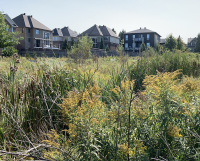RVCA Responds to Province’s More Homes Built Faster Act
RIDEAU VALLEY, Nov. 10, 2022 – Taxpayers, municipalities and our natural systems will bear the costs of the Province’s affordable housing legislation released last month.
While the Rideau Valley Conservation Authority strongly supports efforts to address the ongoing housing crisis, many of the proposed changes related to conservation authorities will have significant impacts and costs while doing little to increase housing supply.
“Improvements to the system must never be at the expense of protecting people and their properties from flooding, erosion and slope failures, or protecting the very features that reduce these risks such as wetlands,” said Sommer Casgrain-Robertson, General Manager of the Rideau Valley Conservation Authority.
Proposed changes and their impacts:
- Weakening the regulatory ability of CAs to protect people and property from natural hazards like flooding, erosion and slope failures - leading to greater risk of property damage and public safety.
- Eliminating the CA’s ability to address water quality issues through planning and permitting, leading to increased nutrients and sediment in lakes and rivers. We know from the 1990s this causes excessive weed growth and algae blooms that have economic impacts on property values, agriculture, tourism, recreation, fisheries and sources of drinking water for many residents.
- Reducing wetland evaluations and protections, leading to increased flooding, erosion and drought, as well as diminished groundwater, which is the source of drinking water in much of rural Ontario. Studies have shown the loss of wetlands in the Rideau watershed would increase flood levels by 10%.
- Downloading more responsibilities to municipalities who have indicated will lead to inefficiencies, delays and increased risk and costs.
- Freezing development fees, which will pass development costs to taxpayers instead of growth paying for growth.
“We are calling on the Provincial Government to reconvene their multi-stakeholder Conservation Authorities Working Group to consider the impacts of these proposed changes,” said Casgrain-Robertson, who is a sitting member of the working group. “The working group has proven it can provide effective recommendations to government that increase housing supply without jeopardizing public safety, dismissing natural systems or downloading additional responsibilities to municipalities.”
The Ontario Association of Municipalities (AMO) shared similar concerns, stating “many of the proposed amendments to the Conservation Authorities Act and the Planning Act in Bill 23 are concerning, as they signal a move away from environmental protection at a time when climate change impacts are being felt more at the local level. Bill 23 proposes sweeping changes to the regulatory responsibilities of Ontario’s 36 conservation authorities that, if passed, will undermine the collaborative and productive changes put forward by the Ministry led Conservation Authority Working Group over the past two years”.
It is well understood that water flows across municipal boundaries – and so do the impacts of development. That’s why over the past 70 years, municipalities have formed 36 CAs across Ontario to assess and understand the cumulative impact of development within each watershed. At a time when climate change is causing more frequent and intense storm events, the role of CAs has never been more critical.
“CAs have proven they are not a barrier to development, but rather facilitate sound and reasonable growth,” said Pieter Leenhouts, Chair of the Rideau Valley Conservation Authority. “They have been modernizing their policies and procedures, streamlining approvals, reducing timelines, meeting and reporting on service standards and promoting pre-consultation with applicants to provide the best service possible to municipalities, communities, residents and developers.”
Not a barrier:
- The Province’s “Housing Affordability Task Force Report” introduced 55 recommendations to increase the housing supply in Ontario, and CAs were not named within the report.
- CAs save municipalities and developers time and money, as the cost-efficient CA system allows member municipalities to share the expertise of CA hydrogeologists, biologists and engineering staff to review planning applications instead of each hiring their own – a huge savings for taxpayers.
- CAs also save the Province and taxpayers money by reducing the financial impacts of severe flooding like Eastern Ontario experienced in 2017 and 2019. The province’s own Special Advisor on Flooding, Doug McNeil, in his 2019 report found that Ontario’s unique CA system remains the fundamental reason why Ontario has not seen the same catastrophic flooding impacts in the billions of dollars as Alberta and BC, which do not have CAs to direct development away from high-risk areas.
“CAs are recognized as a cost-efficient, collaborative partner,” said Casgrain-Robertson. “We are committed to helping Ontario meet its housing goals by ensuring safe and sustainable development that balances the needs of people and the environment, the economy, and local ecology.”
For more information about the RVCA and CA roles and responsibilities, visit www.rvca.ca.
To learn more, or to provide input on the proposed changes, visit the Environmental Registry of Ontario for these Notices:
- Proposed updates to the regulation of development for the protection of people and property from natural hazards in Ontario (ERO number 019-2927)
- Legislative and regulatory proposals affecting conservation authorities to support the Housing Supply Action Plan 3.0 (ERO number 019-6141)
ERO 019-2927 also includes a Consultation Guide on how to provide your input.
To read Bill 23, visit the Ontario Legislative Assembly at this web page at Bill 23, More Homes Built Faster Act, 2022
-30-
